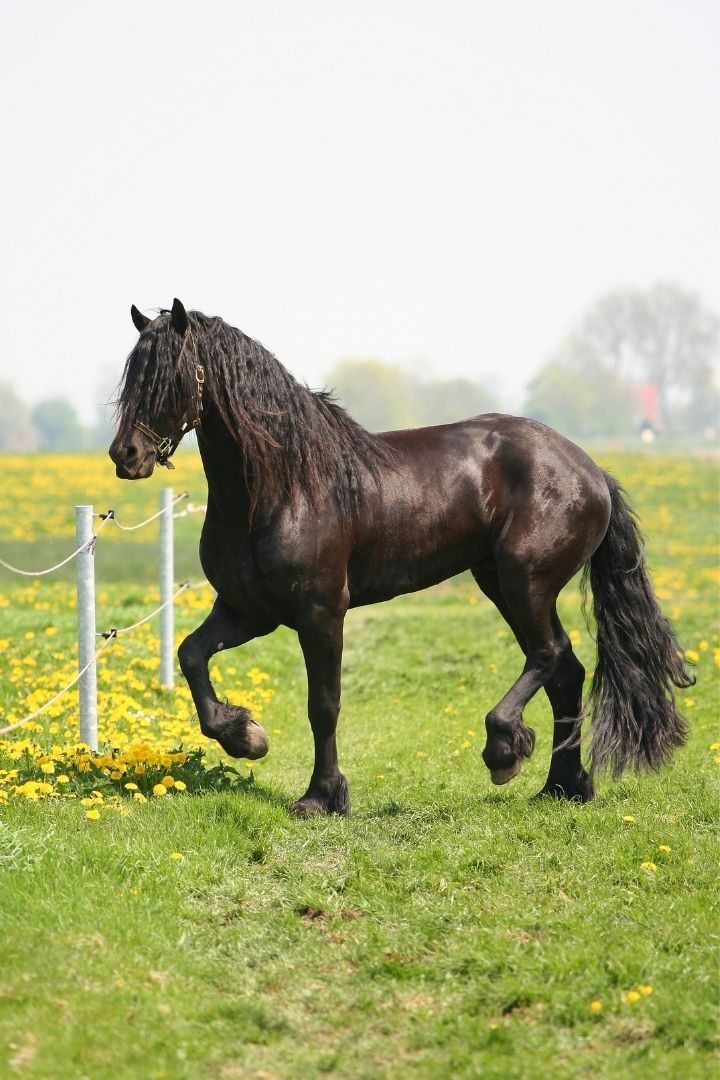
A Friesian horse can resemble a draft horse when it is standing still. Then, the Friesian horse starts moving, and they are the picture of grace, elegance, and athleticism. The Friesian horse has a solid black body, long flowing mane, and tail, feathers on their legs, and are a taller height, creating a striking image. Friesians have the arched neck and solid bone structure of Baroque breeds, a classification that Friesians belong to. This body type combined with the elegance and athleticism creates an enchanting picture.
Friesland is a province in the Netherlands and that’s where the Friesian horse breed developed. Agriculture and farming are the primary industry in Friesland. Next, they were bred during the Middle Ages to carry knights in battle. Friesians were primarily used on the farms, pulling wagons, and carrying riders. The breed has had its ups and downs, and a couple of close calls with extinction but is thriving today and gaining popularity.
History of the Friesian Horse
The breed takes its name from the geographic location and the members of the Friesian army that the horses used to regularly carry. The horse is first mentioned in the 11th century. William the Conqueror is thought to have ridden a Friesian.
Outcrosses to other breeds improved the Friesian horse in the 12th and 13th centuries, including the Arabian horse. Then, in the 16th and 17th centuries, when the Netherlands and Spain were connected, Andalusians were crossed with Friesians. This produced the lighter body type we are familiar with today. Friesians owe much of their history to the monks that bred them, similar to the Andalusian and Lusitano breeds.
The United States had Friesians imported beginning in 1625. They have long been a popular breed here. They influenced many of our American breeds, including the Morgan horse. There were no new imports for hundreds of years. A breeder in Ohio started importing Friesians again in the 1970s and revived the breed in the United States.

Near Extinction
One of the heydays of Friesian popularity was in the 18th and 19th centuries when they were being used on farms, competed in trotting races, and ridden. The breed contributed to the founding of multiple other breeds. In the late 1800s, there was a split in breeding principles among two types of Friesians. The breed’s popularity led to many exports. Both these factors meant the breed was almost eliminated. At one point they were down to three breeding stallions. The two competing breed types merged to preserve the breed. A society was formed in 1913 in the Netherlands to protect and promote the breed.
Breed Characteristics
So, I bet you thought that all Friesian horses were black. To be honest, so did I, but they do carry a chestnut gene, and occasionally you can find a chestnut Friesian. Chestnut stallions cannot be registered and bred in the Netherlands though. In the 1930s there were bay and chestnut Friesians. The black color gene is dominant as we can see for ourselves! Most Friesians have no white markings. Occasionally you find one with a small star. The American Friesian Association does register Chestnuts and Friesians with white markings.
Friesians have an average height of around 15.3 hands high; although they range from 14.2 to 17 hands. Horses must be at least 15.2 hands to earn a star designation at the breed inspections. Those breed inspections maintain the breed integrity and type.

Trot On
The trot is a primary gait for Friesians. Early breed uses including carriage driving, farm work, and carrying soldiers prioritized this gait. Their trot is one of the features that makes them elegant. Friesians have a high-stepping trot where their knees come up almost level with their forearm. They also have great personalities and are docile and intelligent.
Trotting races were a popular use for Friesians. Entire festivals were organized around these trotting races where the winners received a golden whip. Circuses also used Friesians in the 1930s and 40s.
“Sjees” are carriages that Friesians pull. It means a chair on wheels in French. They have tall wheels, each with 14 spokes. Sjees are still popular and used at horse shows, with the driver and attendant wearing replica outfits from the 1860s.
The Friesian Horse Today
Breed numbers continue increasing, and the Friesian is well-established. Although they only represent about 7% of all horses in the Netherlands but are gaining popularity. Friesian horses have had notable success in dressage and carriage driving. Prominent trainers have given accolades to Friesians, helping their position among the baroque breeds and with sport horse programs. Single and pairs driving are both popular uses. Friesians are also popular in Hollywood and with movie production companies in other areas for their calm demeanor and good looks. Although the past was not always easy for the Friesian horse, they have secured their place in the present and future.
Sources: Friesian Horse Association, US Equestrian, Learning Center, and Oklahoma State University.
